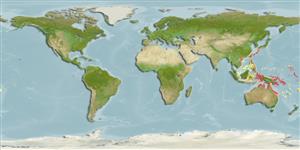>
Gobiiformes (Gobies) >
Microdesmidae (Wormfishes) > Ptereleotrinae
Etymology: Aioliops: Greek, aiolias, -ou = a fish (Scaridae) + Greek, ops = similar (Ref. 45335).
More on authors: Rennis & Hoese.
Environment: milieu / climate zone / depth range / distribution range
Ecologia
marino associati a barriera corallina; distribuzione batimetrica 2 - 10 m (Ref. 90102). Tropical
Western Central Pacific: Papua New Guinea and Indonesia.
Size / Peso / Age
Maturity: Lm ? range ? - ? cm
Max length : 2.3 cm TL maschio/sesso non determinato; (Ref. 90102)
Short description
Chiavi di identificazione | Morfologia | Morfometria
Spine dorsali (totale) : 6 - 7; Raggi dorsali molli (totale) : 9 - 10; Spine anali: 1; Raggi anali molli: 9 - 10.
Occurs in small aggregations above coral thickets; inhabits sheltered shoreline and lagoon reefs in 2-10 m (Ref. 90102).
Life cycle and mating behavior
Maturities | Riproduzione | Spawnings | Egg(s) | Fecundities | Larve
Kailola, P.J., 1991. The fishes of Papua New Guinea: a revised and annotated checklist. Vol. III. Gobiidae to Molidae. Research Bulletin No. 41, Research Section, Dept. of Fisheries and Marine Resources, Papua New Guinea. 153 p. (Ref. 6771)
IUCN Red List Status (Ref. 130435)
Threat to humans
Harmless
Human uses
Strumenti
Special reports
Download XML
Fonti Internet
Estimates based on models
Preferred temperature (Ref.
123201): 28.1 - 29.2, mean 28.8 °C (based on 225 cells).
Phylogenetic diversity index (Ref.
82804): PD
50 = 0.5625 [Uniqueness, from 0.5 = low to 2.0 = high].
Bayesian length-weight: a=0.00389 (0.00180 - 0.00842), b=3.12 (2.94 - 3.30), in cm total length, based on all LWR estimates for this body shape (Ref.
93245).
Trophic level (Ref.
69278): 3.0 ±0.4 se; based on size and trophs of closest relatives
Fishing Vulnerability (Ref.
59153): Low vulnerability (10 of 100).
Nutrients (Ref.
124155): Calcium = 281 [117, 664] mg/100g; Iron = 1.02 [0.51, 2.07] mg/100g; Protein = 17.7 [16.3, 19.0] %; Omega3 = 0.108 [0.047, 0.247] g/100g; Selenium = 13.1 [4.4, 39.2] μg/100g; VitaminA = 710 [167, 2,944] μg/100g; Zinc = 3.13 [1.80, 5.17] mg/100g (wet weight);
